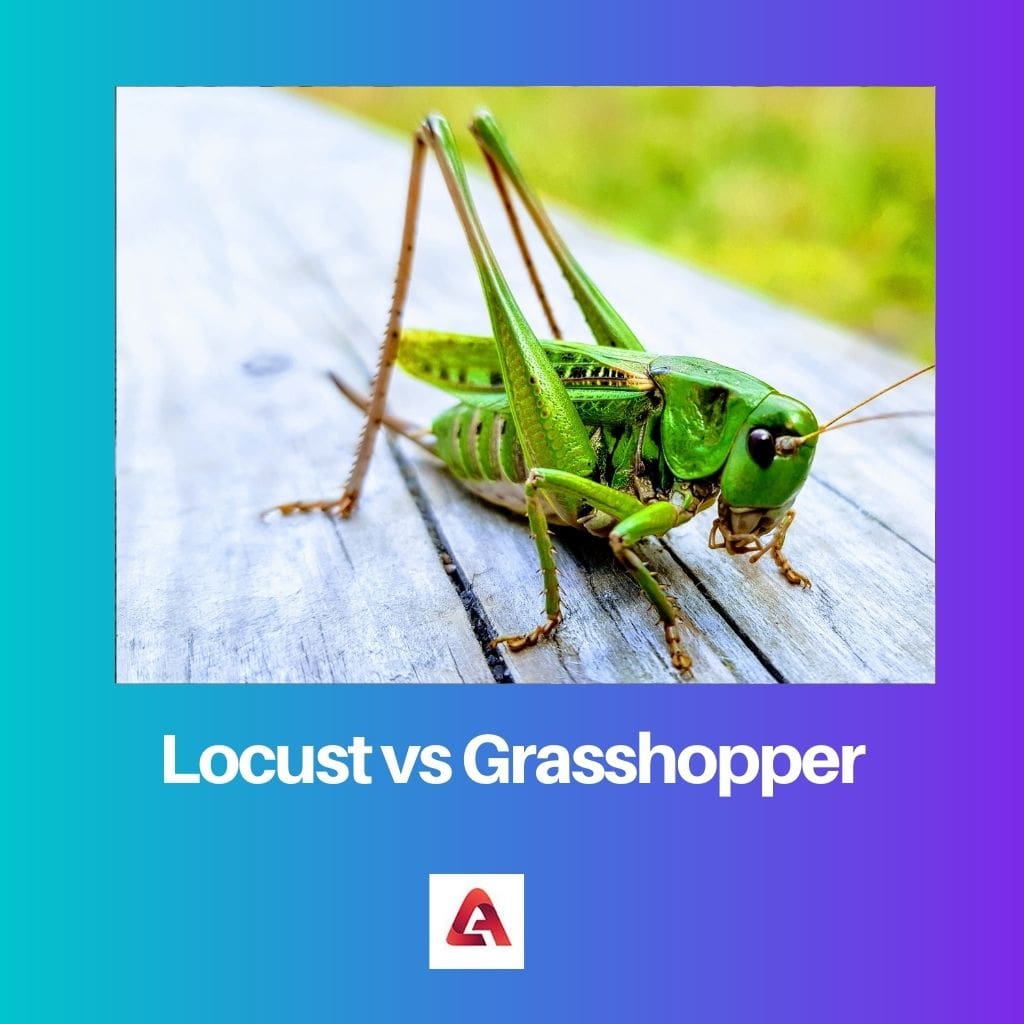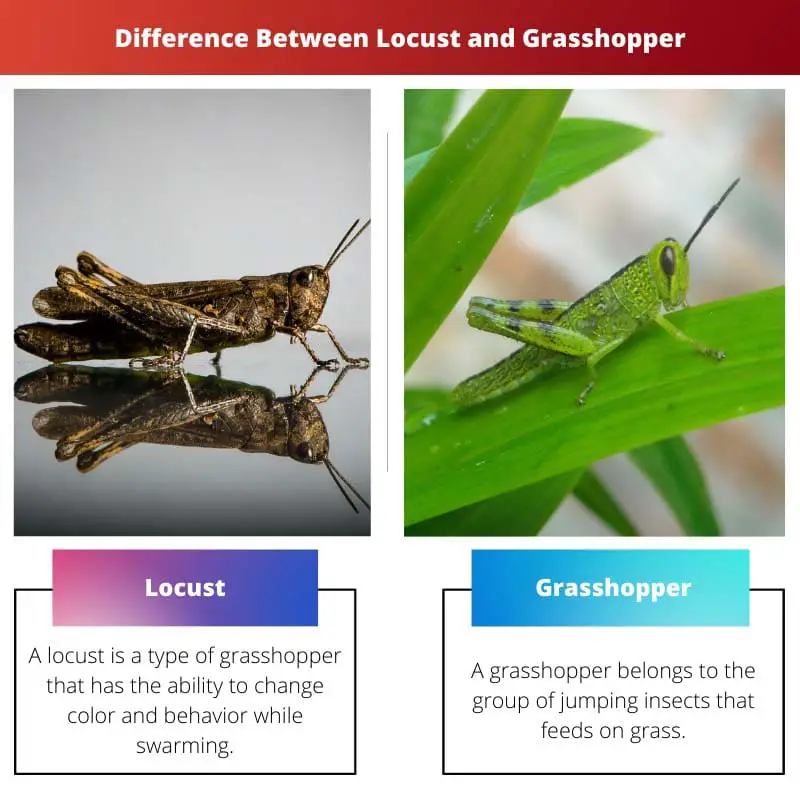Locusts and grasshoppers are closely related insects, both belonging to the order Orthoptera. While grasshoppers typically lead solitary lives, locusts have the ability to form swarms under certain conditions, exhibiting a remarkable change in behavior and physiology.
Key Takeaways
- Locusts are a type of grasshopper known for their ability to form swarms and cause significant agricultural damage.
- Grasshoppers do not swarm and are less likely to cause large-scale damage to crops.
- Both locusts and grasshoppers are part of the order Orthoptera, but locusts exhibit unique swarming behavior due to environmental triggers.
Locust vs Grasshopper
The difference between Locusts and Grasshopper is their behavioural pattern. They are pretty different in their state of existence, adaptability, colours, and suborder.

Comparison Table
| Feature | Locust | Grasshopper |
|---|---|---|
| Scientific Classification | Family: Acrididae | Suborder: Caelifera, various families |
| Behavior | Primarily gregarious (forms large swarms) | Primarily solitary (lives alone) |
| Wing Structure | Stronger and longer wings for sustained flight | Weaker and shorter wings for short bursts of flight or gliding |
| Body Size | Generally larger than grasshoppers | Variable in size, but generally smaller than locusts |
| Swarming | Known for forming large, dense swarms that can devastate crops | Rarely form swarms and typically only in small numbers |
| Habitat | Found in warm and dry climates, often near grasslands and deserts | Found in various environments, including grasslands, forests, and meadows |
| Diet | Primarily herbivores, feeding on leaves, grasses, and crops | Primarily herbivores, feeding on leaves, grasses, and flowers |
| Impact on Agriculture | Can cause significant agricultural damage due to large-scale swarms | Minimal impact on agriculture due to solitary behavior |
What is Locust?
A locust is a type of insect belonging to the family Acrididae, known for its ability to undergo rapid and dramatic changes in behavior and appearance under specific conditions. These conditions typically involve overcrowding and environmental stressors, leading to the formation of swarms.
Anatomy and Characteristics
- Physical Appearance: Locusts are typically grasshopper-like insects with powerful hind legs adapted for jumping. They have elongated bodies, wings, and antennae, and they come in various colors, including shades of brown, green, and yellow.
- Behavioral Plasticity: What distinguishes locusts from ordinary grasshoppers is their ability to exhibit significant behavioral plasticity. When population density increases and resources become scarce, locusts can transition from solitary individuals to gregarious swarms.
Life Cycle
- Solitary Phase: In their solitary phase, locusts behave much like ordinary grasshoppers. They live independently, feed on vegetation, and reproduce individually.
- Gregarious Phase: Under specific conditions such as drought, overgrazing, or changes in vegetation patterns, locusts undergo a behavioral transformation. They become gregarious, forming swarms that can contain millions of individuals. During this phase, locusts exhibit synchronized behavior, flying in dense clouds and causing widespread devastation to crops and vegetation.
Environmental Impact
- Agricultural Damage: Locust swarms can have devastating effects on agriculture, causing massive crop losses and threatening food security in affected regions. They can strip fields bare of vegetation within a matter of hours, leading to famine and economic hardship for communities reliant on agriculture.
- Management and Control: Managing locust outbreaks involves a combination of monitoring, early detection, and control measures such as insecticide spraying, biopesticides, and habitat modification. International cooperation and coordinated efforts are often necessary to mitigate the impact of locust plagues on a large scale.

What is Grasshopper?
Grasshoppers are a type of herbivorous insect belonging to the order Orthoptera, known for their ability to leap significant distances and for their distinct chirping sounds. They are found in various habitats worldwide, including grasslands, forests, and agricultural areas.
Anatomy and Characteristics
- Physical Appearance: Grasshoppers typically have elongated bodies with large hind legs adapted for jumping. They possess two pairs of wings, with the front wings, known as tegmina, being narrow and leathery, while the hind wings are broader and membranous. Their antennae are relatively short compared to those of locusts.
- Feeding Habits: Grasshoppers are primarily herbivorous, feeding on a wide range of plant species. They use their powerful mandibles to chew through vegetation, making them significant pests in agricultural settings when populations are large.
Life Cycle
- Egg Stage: Grasshoppers undergo incomplete metamorphosis, meaning they develop through three stages: egg, nymph, and adult. Female grasshoppers lay their eggs in the soil during the fall or early spring, where they overwinter until conditions are favorable for hatching.
- Nymph Stage: Upon hatching, grasshoppers emerge as nymphs, resembling miniature versions of adults but lacking fully developed wings. Nymphs undergo several molts, shedding their exoskeletons as they grow larger.
- Adult Stage: Once they reach maturity, grasshoppers become capable of reproduction and develop fully functional wings. Adult grasshoppers typically live for several weeks to months, depending on environmental conditions and predator pressure.
Behavior and Ecology
- Movement and Communication: Grasshoppers are adept jumpers, using their powerful hind legs to propel themselves away from predators or to travel between feeding sites. They also communicate through chirping sounds produced by rubbing their wings or legs together, primarily as a means of attracting mates.
- Ecological Role: Grasshoppers play important roles in ecosystem dynamics as both consumers of vegetation and prey for various predators, including birds, rodents, and other insects. Their feeding habits can influence plant populations and community structure in grassland and agricultural ecosystems.
Economic and Ecological Impact
- Pest Management: While grasshoppers are an essential part of natural ecosystems, they can become significant pests in agricultural settings, particularly during outbreaks when populations surge and cause extensive damage to crops and forage plants. Integrated pest management strategies, including biological control methods and insecticides, are often employed to mitigate their impact on agricultural production.
- Biodiversity: Despite their pest status, grasshoppers contribute to biodiversity and ecosystem functioning by serving as prey for numerous predators and by influencing plant community dynamics through herbivory. Maintaining balanced grasshopper populations is essential for sustaining healthy ecosystems and agricultural landscapes.

Main Differences Between Locust and Grasshopper
- Behavioral Plasticity:
- Locusts exhibit remarkable behavioral plasticity, capable of transitioning from solitary individuals to gregarious swarms under specific environmental conditions.
- Grasshoppers typically remain solitary throughout their lives and do not undergo such dramatic behavioral changes.
- Swarming Behavior:
- Locusts form dense swarms consisting of millions of individuals when triggered by overcrowding, resource scarcity, or environmental stressors.
- Grasshoppers do not exhibit swarming behavior; they live independently or in small groups and do not form large, cohesive swarms.
- Impact on Agriculture:
- Locust swarms can cause widespread agricultural devastation, stripping fields bare of vegetation and threatening food security in affected regions.
- While grasshoppers can be agricultural pests, their impact is generally less severe compared to locusts, as they do not swarm in the same manner and are typically manageable through conventional pest control methods.

- https://www.cabdirect.org/cabdirect/abstract/19921175487
- https://www.jstor.org/stable/3503459
- https://pdfs.semanticscholar.org/a3be/48daf15e48ac2674cfc9367a9642f2071a5d.pdf

Grasshoppers’ adaptability and diverse habitats make them a fascinating subject of study. The article effectively highlights their ecological role and contributions to the food chain within ecosystems.
Absolutely, the ecological significance of grasshoppers as herbivores and their adaptability to various environments emphasizes the need for their conservation and management.
The economic and agricultural impact of locust plagues is a significant concern, especially for regions heavily reliant on staple food crops. The article underscores the severity of agricultural losses and the need for effective control measures.
Indeed, the agricultural impact of locust swarms demands international cooperation and sustainable control strategies to minimize food shortages and economic hardships.
This article effectively elucidates the relatively lesser-known aspects of locusts and grasshoppers, shedding light on their distinctive features and the differences in their impact on agriculture. It’s a valuable read for those interested in entomology.
Absolutely, the article provides a comprehensive overview, enriching our understanding of locusts and grasshoppers from an ecological and agricultural standpoint.
This article provides an insightful comparison between locusts and grasshoppers, shedding light on their behavioral differences and potential agricultural impacts. It’s crucial information for understanding these insects’ ecological significance and the challenges they pose.
The detailed comparison table is particularly helpful in differentiating between locusts and grasshoppers, providing a clear overview of their characteristics and behaviors.
Absolutely, understanding the distinction between locusts and grasshoppers is essential for managing potential outbreaks and mitigating agricultural damage.
The emphasis on international cooperation for monitoring and controlling locust outbreaks underscores the global nature of the challenge. It’s essential for addressing transboundary locust infestations effectively.
Indeed, the international collaboration highlighted in the article is vital for managing the impact of locust swarms on a global scale and ensuring sustainable control methods.
The intricate details regarding the life cycle, environmental triggers, and economic impact of locust swarms enrich our understanding of these insects’ complex dynamics and implications for agricultural systems.
Absolutely, the comprehensive insights into locust biology and behavior provide valuable knowledge for addressing the challenges posed by their swarming behavior.
The article presents a rich resource of information on the behavioral patterns, ecological roles, and agricultural implications of locusts and grasshoppers. It’s a compelling read for those interested in insect ecology and pest management.
I couldn’t agree more. The article’s comprehensive coverage enhances our understanding of these insects and their ecological and agricultural significance.
The transformation of locusts from a solitary to a swarming phase in response to environmental triggers is a fascinating phenomenon. The article effectively highlights the factors contributing to this behavioral change and its implications for agriculture.
I found the section on environmental triggers and the gregarious phase of locusts particularly intriguing. It emphasizes the role of climate events in influencing locust population dynamics.
The article provides a comprehensive understanding of the behavioral characteristics, ecological significance, and agricultural impact of locusts and grasshoppers. It serves as a valuable resource for researchers and policymakers alike.
Absolutely, the detailed insights into locusts and grasshoppers offer valuable knowledge for devising effective management and conservation strategies.
The comprehensive explanation of the life cycle and behavioral differences between locusts and grasshoppers provides valuable insights into their ecological and agricultural implications. It’s a well-researched piece.
I couldn’t agree more. The article’s emphasis on the life cycle and behavioral distinctions enhances our understanding of these insects’ ecological and economic significance.